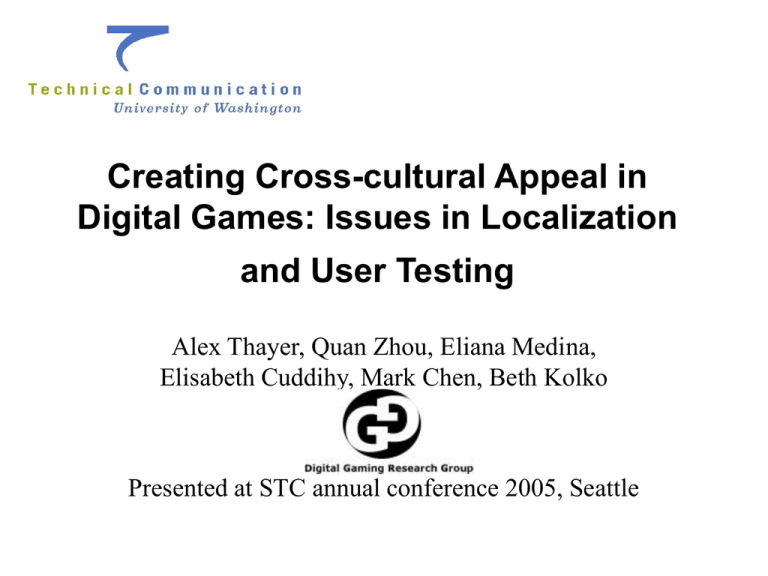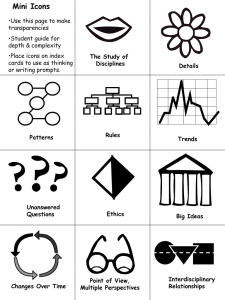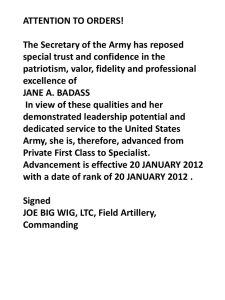
Creating Cross-cultural Appeal in
Digital Games: Issues in Localization
and User Testing
Alex Thayer, Quan Zhou, Eliana Medina,
Elisabeth Cuddihy, Mark Chen, Beth Kolko
Presented at STC annual conference 2005, Seattle
An Overview of Digital Games,
Globalization & Localization
Alex Thayer, M.S.T.C.
Definition of Terms
• What does the term “digital game” include?
– Computer games (Half Life, EverQuest, Solitaire)
– Console games (PS2, Xbox, GameCube games)
– Arcade games, mobile device games, and more
• What is the difference between
“productivity” applications and digital
games?
– Productivity applications (Word, Excel, Photoshop,
etc.) facilitate work; digital gaming applications
facilitate play
– Although some overlap is possible, work and play
are two discrete types of computer-based activity
General Relevance of the Research
• Games are a multibillion dollar industry:
– Over $10 billion in the US by some estimates
– The world market is even larger
– Companies are eager to market to multiple
countries in order to recoup development
expenses
• Game interfaces can inform the interface
design of productivity applications:
– Human-computer interaction researchers and
interface designers are looking at games
– Game developers have produced creative
solutions to several UI design challenges
Relevance of Research to Technical
Communication
• TC practitioners have a wealth of relevant
professional experience:
– We know how to perform many tasks during the
localization process
– We bring cross-cultural awareness to a project
– We understand complex ideas about users and
audiences
• TC practitioners can learn from game
documentation:
– Some game manuals have won competitions
– Some games have integrated systems that offer
innovative ideas for context-sensitive Help
Definitions of Translation,
Globalization, and Localization
• Translation: straightforward language
conversion
• Globalization: one product fits nearly all
• Localization: altering a product so it suits a
specific country or region
– Goes beyond translation
– Often deals with UI issues
– Requires significant time and resources
Overview of Localization Process for
Productivity Applications
• The user interface must be changed:
– Icons may or may not need to be redrawn
– Menu and message text must be translated
– Documentation must also be translated
• Cultural stereotypes must be removed:
– Colloquialisms, slang, and potentially
offensive terms and images must be
changed
Localization: How is the process
different for digital games?
Overview of Localization Process for
Digital Games
• User interface
• Stereotypes
• Storyline or narrative
• Ratings, violence, and the issue of local
law
UI and Stereotypes in Digital Games
• The user interface must be changed:
– Icons may or may not need to be redrawn
– Menu and message text must be translated
– Documentation must also be translated
• Cultural stereotypes must be removed:
– Gender, race, and other game design
factors require close examination
– Heroes/enemies might need realignment
Storyline and Violence in Digital
Games
• The storyline might need some revision:
– The application defines the user’s goals
– Certain types of narratives or settings are not
necessarily appropriate for certain cultures
• The game rating is an important factor in
certain countries:
– Germany and South Korea have more stringent
rules on violence
– The EU has adopted a general rating system
– Plan for green blood and robots!
Digital Game Localization: Three
Levels of Cost and Time Required
• Basic localization:
– The game retains its original GUI and icons,
leaving only the text to be translated
• Complex localization:
– The GUI and icons must be translated along with
the text
• Blending:
– The narrative is rewritten and the graphics are
recreated to match the interests of a different
culture
– The UI and icons might be changed or they might
remain the same
Basic Digital Game Localization: A
Bad Example
• Avoid the “all your base” syndrome:
Good text translation makes a difference
Basic Digital Game Localization: A
Better Example
• Final Fantasy:
The story holds the appeal; players are
willing to learn the game as they play it
Complex Digital Game Localization:
A Good Example
• Crash Bandicoot:
–The Japanese press
predicted failure…
–…900,000 copies sold,
spawning a few
successful sequels
Complex Digital Game Localization:
A Few More Good Examples
• Sierra had to alter Half Life for audiences
around the world:
– Robots replaced human enemies
– Blood changed from red to green
– Gamers bought it anyway, despite age restrictions
and less violent content
• The list of successful international games is
quite long (Starcraft, Age of Empires, etc.)
Digital Game Blending: A Good
Example
• Legend of Darkness is a Korean game:
– The developers redesigned the story and
gameplay for a US audience:
• More emphasis on role-playing, politics, and religion
• Added elements of “Gaelic and Lovecraftian horror”
– The result (Dark Ages) remains successful in the
US
• However, not all games are suitable for
blending:
– The appeal of the Harry Potter series is in the
original storyline and characters
– The same is true of sports, movie-based, and other
literature-based titles
Digital Games Localization
Model and a Case Study in China
Quan Zhou (Chwen Joe), TC Ph.D.
student
Game Localization: Unique
Characteristics of Games
• Three Aspects of Digital Games to Consider:
– Games are a cultural product, and they are influenced
by the cultural background of the designers.
– The external environment of games is unique (to the
entertainment sector).
– Digital games’ target audience is unique (to the
entertainment sector).
– Digital game localization relates to various
characteristics, both inside the game, and out in the
real (non-game) world.
A Three Dimensional Approach
• Dimension 1: In-Game Environment: includes
factors embedded in the game and that are
developed during game design.
• Dimension 2: External Environment: includes
external factors such as social issues, political
issues, legal issues, ideological issues.
• Dimension 3: Users: includes cultural background
of players, conventions, game-playing contexts,
attitudes and habits towards games, the role of
games in everyday life.
Digital Games in China
• China's online gaming industry: sales revenue of 1.3
billion Yuan (about 157 million US dollars) in 2003;
more than 13.8 million online players
• In 2003, online game software development plan
written into "863 High-Tech Program"
• “Koreanization”: More than 70% digital games in
China from South Korea.
• Top 10 game ranking: 80% Asian games, 50% Korean
games, few western countries, U.S. being the only one
on the list this week. (World of Warcraft).
Case Studies
•
•
•
•
Less popular and failed games in China
Successful games in China
EverQuest case
Localization issues beyond China
Project IGI2: Covert Strike
• Game produced by Norway-based
Innerloop Studios AS
• “intentionally blackening China and
the Chinese army's image as a
freelance mercenary fights in the game
across three linked campaigns in the
former Soviet Union, Libya and China,
where he steals intelligence and
conducts sabotage in China and shoots
at China's soldiers while China's
national flag and signs like "China
Aviation" pop up frequently”
Soccer Manager 2005
• “Contained content that harmed
China's sovereignty and territorial
integrity and violated Chinese law
(MSNBC). Any Web site that
offered downloads of the game
would be fined up to 10,000 Yuan
($1,210)”
Hearts of Iron II
• Swedish-made computer game
• Banned in China for "distorting history and
damaging China's sovereignty and territorial
integrity," the Ministry of Culture (MOC).
• Claimed to “severely distort historical facts and
violate China's gaming and Internet service
regulations.”
• “"Manchuria", "West Xinjiang", and "Tibet"
appeared as independent sovereign countries in
the maps of the game.”
• Included Taiwan as the territory of Japan at the
beginning of the game.
Command and Conquer Generals: Zero
Hour Expansion
• Game produced by
Electronic Arts (EA)
• Banned in 2003 for
"smearing the image of
China and the Chinese
army," according to the
state news agency.
• 50 other games banned:
pirate copies, “negative
influence” on young
people, pornography
Successful Games: Lineage, Ro
• Korean games
Corum (Korean)
World of Warcraft
• U.S. game
• No. 1 this week
EverQuest vs. Mu
• EverQuest ranks high in the Western digital
market for MMORPGs; the top two digital games
in the Chinese market are Lineage and Mu with 2
million and 5 million subscribers each.
• EverQuest was initially not on the TOP 10 list
• Improved EverQuest II: oriental/Asian version
EverQuest oriental version
EverQuest western original
Localization Evolution:
EverQuest US vs. Asia
Localization Evolution
Localization Evolution
Beyond China
• U.S.A.
– The governor of Washington state recently signed a bill
“that bans the sale of certain violent video games to
minors”; video games that contain a specific type of
violence
– News Tribune reports that House Bill 1009 makes it a
civil violation to sell or rent to youths under age 17
video games that graphically depict violence against
law enforcement officers; fine up to $500.
Beyond China
• Europe
– Similar bans on violence in Greece and Germany:
Return to Castle Wolfenstein caused Germany's government
to call for the removal of Nazi characters from the game.
Activision's homepage with a warning.
• Australia
Localization of Games
• Three-dimension approach reflected
through the examined facts.
• Not at the end, but at the beginning
Engagement & Motivation
• Mark Chen, PhD student in Education
• Elisabeth Cuddihy, PhD student in TC
• Eliana Medina, PhD student in Education
Modeling Engagement
• What are the aspects that make a game engaging?
• Engagement: The psychological state caused by
strong focus of attention in which one is drawn into
the game.
• Our working model of engagement draws upon:
– Flow Theory (Mihaly Csikszentmihalyi)
• Flow: The state in which people are so involved in an activity
that nothing else seems to matter & they are highly motivated
– Presence Theory (Virtual Reality research)
• Presence: The sense of being inside a virtual reality.
– Narrative theory from film & drama, social computing,
emerging theories from games research.
Engagement Model for Digital Gaming
Interface
Usability
Interface
Fidelity
Personal
Identification
Engagement
Attention, Task
Performance,
& Motivation
Personal
Interest
Social
Relationships
Interface
Usability
Interface
Interface
Usability
Fidelity
How do the hardware & software UI
affect engagement during game play?
Personal
Identification
• Good system responsiveness
Engagement
• Appropriate & effective choice of
hardware and software user interface
Attention, Task
• Predictable
interaction via the user
Personal
Performance,
interface
(hardware/software)
Interest
& Motivation
Social
Relationships
System Responsiveness &
Appropriate UI
• Will gaming input
devices work on target
platform?
• Will the target game
platform have enough
memory if translated text
is larger in size?
• Does the game engine
have full support for 16bit UNICODE fonts?
Predictable UI Interaction
Some things to check:
• Do the icons use metaphors that require cultural
knowledge to understand and may be
misunderstood?
– Metaphors from western fairy tales (e.g., Warcraft
III’s hex spell uses a frog icon)
• Is the color symbolism meaningful or counterintuitive for the target culture?
Interface Fidelity
Interface
Interface
Usability
Fidelity
What is the quality of the audio,
graphs, and animation/video?
Personal
Identification
• Can be understood by the players
Engagement
• Can be enjoyed by the players
• Does not detract from game play
Attention, Task
Personal
Social
Performance,
Interest
Relationships
& Motivation
Moderators of Interface Fidelity
Inaudible voices,
unfamiliar accents
Interface
Fidelity
Subtitles
Poor or distorted
audio
Key:
Distraction
Clearly audible
voices
Reinforcement
Readable fonts,
clear graphics
Jittery video or
animation
Smooth
graphics
Text/graphics do
not fit on screen
Interface
Usability
Personal
Identification Personal
Interface
Fidelity
Identification
Is the player able to identify with the
games rules, customs, & world?
• Able to project oneself into the game
Engagement
• Able to accept the game world as real
while playing
Attention, Task
Performance,
& Motivation
Personal
Interest
Social
Relationships
Indentification with Game World
• Does the game world help or hinder a player’s
ability to project oneself into the game?
• Is the environment culturally accepted? Culturally
understandable?
–
–
–
–
Levels of sex and violence
Selection of music and graphics
Costumes and character (avatar) appearance
References to religion, mythology, and pop-culture
• Consider using cultural notes (popular in manga and anime)
Attention,
Task Performance
&
Interface
Interface
Motivation
Usability
Fidelity
What elements in the game could
distract the player’s attention, or affect
task performance and motivation?
Personal
Identification
• Discrepancy betweenEngagement
the player’s
knowledge and the information
presented in the game
•Attention,
Difficulty inTask
understanding the
Personal
Performance,
translated
version of the game
Interest
& Motivation
• Deficient character voice-over
Social
Relationships
Moderators of Attention, T.P., & Motivation
Geopolitical
Conflict
Attention, Task Performance &
Motivation
Specific
Goals
Voice Over
deficiency
Key:
Distraction
Challenge/Skills
Reinforcement
Clear
Feedback
Religious
Conflict
Control
Difficulty with
Translation
Geopolitical Conflict
Religious Conflict
Language Issues
Language Issues
“Awesome, guy” = “Vientos, Güey!”
“I love you, guy” = “Te quiero, mano”
“Great Honor” = “Gran Honor”
“You guys suck” = “Ustedes son unas
maletas”
“Game” = ”Partido”
“It's pretty big” = “Va a ser muy
númeroso”
“Hunters, prepare for combat” =
“Cazas, prepárense para el combate”
Personal Interest
Interface
Interface
Personal
Usability
Fidelity
Identification
Does the game match the player’s
interests?
• Genre, content, theme, characters
Engagement
• Desire to play more
• Involved in game community (hints,
Attention, Task
discussion, fan art/fiction, …)
Personal
Social
Performance,
Interest
Relationships
& Motivation
Social Relationships
Interface
Usability
Interface
Personal
Does the game support socializing?
Fidelity
Identification
• Does the genre have an established
game culture?
• Engagement
How dependent on the game culture
are the meanings of the game’s
narrative, characters, etc?
Attention, Task
Performance,
& Motivation
• Will people from different regions
wantPersonal
to play together?
Social
Interest
Relationships
• To what extent can the game be
modified by users?
Moderators of Social Relationships
Game culture
conflict
Websites
and forums
Social Relationships
No established
game culture
Key:
Distraction
Strong social
network
Reinforcement
Easy to communicate
in-game
Weak social
network
Mods, etc.
No way to
communicate in-game
• Each genre of game has a culture(s) of gamers
associated with the genre.
• Each game within a genre can have its own
micro-culture.
• These cultures have social norms and are
embedded within social networks.
A Stereotypical Gamer
But Actually Not Alone
• Strength of a person’s social network is a huge
factor of whether that person stays with the
game.
• Localization of a game might
– disenfranchise players if they think they are getting
a lesser version
– change the social dynamic that would normally
occur
• In addition to
regional
cultures, there is
the game culture
to consider.
Online Forums
•strategy
•quest help
•IC posts
•coordination
•etc.
A guild is a group of players who have
officially banded together
Mods, machinima, fan art, etc.
To Sum Up…
• Engagement comes from
– elements of the game (Dimension 1)
– relationship between the game and the player
(Dimension 2)
– relationships among players mediated in and
out of the game (Dimension 3)
Engagement Model
Interface
Usability
Interface
Fidelity
Personal
Identification
Engagement
Attention, Task
Performance,
& Motivation
Personal
Interest
Social
Relationships
Digital Gaming Research Group
Dept. of Technical Communication
University of Washington
http://depts.washington.edu/diggames
Materials in this presentation for educational use only












